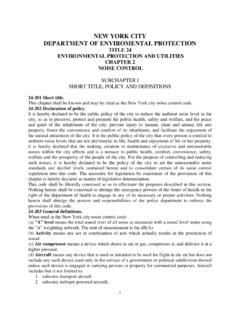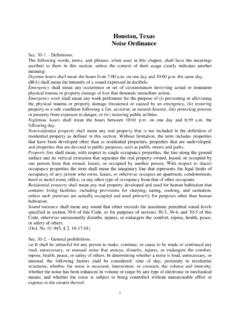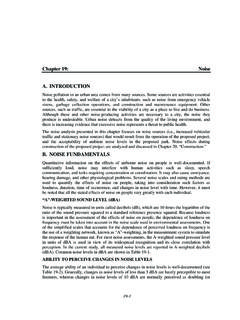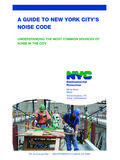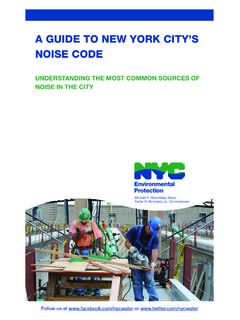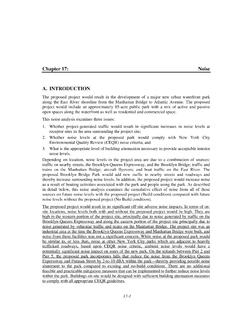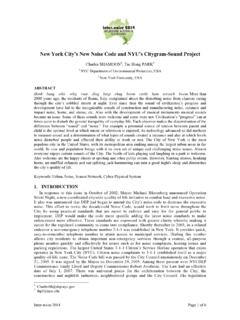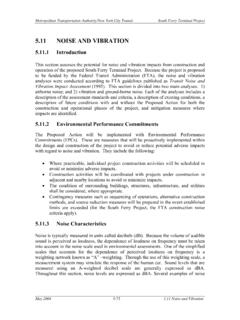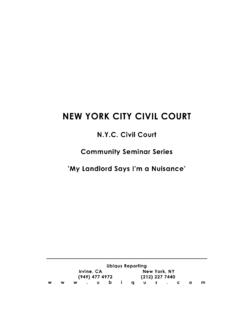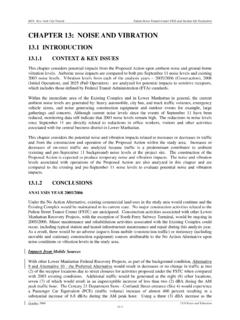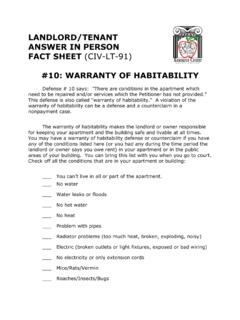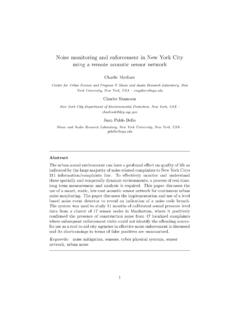Transcription of New York City - noisefree.org
1 1 New york CityNoiseGuidelines andRegulationsNOISECHAPTER 19 noise , in its simplest definition, is unwanted sound. While high noise levels may cause hearingloss, the levels associated with environmental noise assessments are often below thishazardousrange. However, noise levels that are not considered hazardous should not be overlooked, sincethey can cause stress-related illnesses, disrupt sleep, and interrupt activities requiringconcentration. In New york city , with its high concentrationof population and commercialactivities, such problems may be chapter discusses the topic of noise as it relates to regulations and guidelines that governactivities in New york city . It defines technical terms, discusses the appropriatenessof a noiseanalysis, and provides information related to detailed noise analyses, study area definitions,technical subareas, models, and analysis techniques used.
2 Also discussed are methods used byagencies for projects within and outside New york city as well as accepted industry practices forenvironmental noise assessments applicable to New york city projects. Relative to noise , thegoal of CEQR is to determine both (1) a proposed project's potential effects on sensitive noisereceptors, including theeffects on the level of noise inside residential, commercial, andinstitutional facilities (if applicable) and (2) the effects of ambient noise levels on new sensitiveuses introduced by the proposed project. If significant adverse impacts are identified,CEQRre-quires such impacts to be mitigated or avoided to the greatest extent mentioned throughout the Manual, it is important for an applicant to work closely with thelead agency during the entire environmental review process. In addition, the New york CityDepartment of Environmental Protection (DEP) often works with the lead agency during theCEQR process to provide technical review, recommendations and approvals relating to the review identifies the need for long-term measures to be incorporated after CEQR(prior to or during development), DEP, in coordination with the lead agency, determines whetheran Institutional Control, such as an (E) designation, Restrictive Declaration, or Memorandummay be placed on the affected site.
3 The Mayor s Office of Environmental Remediation (OER)has the authority and responsibility for administering post-CEQR (E) designations andRestrictive Declarations recorded on privately-owned DEFINITIONSIn addition to defining technical terms used in a noise assessment, this section providesbackground information to better understand such an SOURCES OF NOISEFor CEQR purposes, the three principal types of noise sources that affect the New york Cityenvironment are mobile, stationary, and construction MOBILE SOURCE NOISEM obile sources are those noise sources that move in relation to a noise -sensitive receptor principally automobiles, buses, trucks, aircraft, and trains. Each has its own distinctive2noise character, and, consequently, an associated set of noise assessment descriptors. Thedetails of these signatures and descriptors are discussedin following STATIONARY SOURCE NOISES tationary sources of noise do not move in relation to a noise -sensitive receptor.
4 Typicalstationary noise sources of concern for CEQR include machinery or mechanical equipmentassociated with industrial and manufacturing operations; or building heating, ventilating,and air-conditioning systems. In addition, noise produced by crowds of people within adefined location, such as children in playgrounds or spectators attending concerts orsporting events and noise produced by concerts or by announcements using amplificationsystems, are considered stationary CONSTRUCTION NOISEC onstruction noise sources comprise both mobile ( , trucks, bulldozers,etc.) andstationary ( , compressors, pile drivers, power tools,etc.) sources. Construction noise isexamined separately in Chapter 22, Construction Impacts, because it is temporary, eventhough the duration of construction activities may last years. The duration of each phase ofconstruction is a factor that should be considered when assessing noise from constructionactivities.
5 See Chapter 22, Construction Impacts, for more BACKGROUND DISCUSSIONThis section provides the reader with a background of the terminology used in noise assessmentdiscussions, the basic physical characteristics of noise , the types and appropriate use of noisedescriptors, and what are considered receptors ( noise -sensitive locations) in the conduct of CHARACTERISTICS OF NOISEThe first step in understanding the impact of sound, its perception, and control is anunderstanding of the source, path, and receptor. The source is the equipment or processdirectly responsible for the sound generation. Thepath is the medium of soundpropagation, such as air, water, or solid materials. The receptor is the final destination ofconcern for the sound in question. For CEQR purposes, the receptor is usually personsbeing affected; the ear of an affected person is the final destination of the noise source ofconcern.
6 Each link of this chain plays a role in producing a resultant sound pressure levelat the SOUND LEVELS: PROPAGATION VELOCITY, WAVELENGTHS ANDFREQUENCIES, AND DIFFRACTIONS ound pressure is the parameter that is normally measured in noise assessments. People'sears respond to acoustic pressures that represent the range from the threshold of hearingto the threshold of pain. This vast range is represented as a logarithmic basic measure of sound is the sound pressure level (SPL), which is expressed in decibels(denoted dB). When the SPL = 0 dB, the acoustic pressure is the same as the threshold ofhearing, or the SPL at which people with healthy hearing can just begin to heara is emitted as a wave of varying length and frequency. A higher frequency sound isperceived as a higher pitch for example, the sound of the flute. A lower frequency is3heard as a lower pitch for example, the sound of the bass drum.
7 The frequency isexpressed in cycles per second or Hertz (Hz): one Hz is one cycle per second. Just as theear cannot hear sound pressure levels below a certain range, it cannot hear somefrequencies above a certain range. The normal range of hearing is 20 Hz to 20,000 Hz or20 kiloHertz (kHz).The velocity of sound, which is constant in air, is governed by the relationship velocityequals wave length times frequency. Therefore, since sound travels at a constant velocityin air, the longer the wavelength, the shorter the frequency, and vice versa. The wavelengthdetermines how the sound interacts with the physical environment. Since sound is a wavephenomenon, it is also subject to diffraction, such as bending around corners. This iswhy a person continues tohear some sound from a source on the other side of a wall that ishigher than the individual in general, hearing is such that a change of 3 dB is just noticeable, a change of 5 dB isclearly noticeable, and a change of 10 dB is perceived as adoubling or halving of soundlevel.
8 In a large open area with no obstructive or reflective surfaces, SPL drops from apoint source of noise at a rate of 6 dB with each doubling of distance from the source. For line sources (such as vehicles on a street), the SPL drops off at a rate of 3 dB(A) witheach doubling of the distance from the source. Over distances greater than 1,000 feet, thismay not hold trueas atmospheric conditions cause changes in sound path and drop-off rate also varieswith both terrain conditions and the presence of the urban canyon environment present in New york city , drop-off rates along citystreets generally range from 2 to 4 dB per doubling of distance from the source because ofsound reflectionsfrom buildings. The drop-off rate should be verified by fieldmeasurements whenever ideal open situations do not exist and a drop-off rate is required inthe noise DESCRIPTORSMany descriptors are commonly used in environmental noise assessments.
9 The choice ofspecific descriptors is related to the nature of the noise signature (SPL, frequency, andduration) of the source and the potential effect it may have on the Sound WeightingSound is often measuredand described in terms of its overall energy, taking all frequenciesinto ac-count. However, the hearing process is not the same at all frequencies. Over thenormal hearing range, humans are most sensitive to sounds with frequencies between 200Hz and 10kHz. Therefore, noise measurements are often adjusted or weighted as afunction of frequency to account for human perception and sensitivities. The most commonweighting networks used are the A-and C-weighting weight scales were developedto allow sound level meters to simulate the frequencysensitivity of the ear. They use filter networks that approximate hearing. The A-weighted networkis the most commonly used and sound levels measured using this weighting are noted as dB(A).
10 The letter A indicates that the sound has been filtered to reduce the strength of very low and veryhigh frequency sounds, much as the human ear does. A listing of common noise sources with theirassociated typical dB(A) values is shown in Table 19-1. Note that the table presents arepresentative range of noise levels, where 0 dB(A) corresponds to the threshold of hearing and120 dBA corresponds to an air raid siren at 50 19-1 noise Levels of Common SourcesThe C-weighted network provides essentially the unweighted microphone sensitivity over thefrequency range of maximum human sensitivity. C-weighted measurements, denoted as dB(C), areusedin some ordinances and standards, usually when dealing with stationary mechanicalnoise sources; however, dB(A) are normally used for environmental assessments. SinceC-weighting does not attenuate frequency levels below1,000 Hz the way A-weightingdoes, inspection of dB(A) versus dB(C) readings may give a quick estimate of the lowfrequency contribution of the sound source in most common descriptors used in environmental noise assessments are (1)time-equivalent level (Leq); (2) day-night level (Ldn); (3) percentile level (Lx); (4) soundexposure level (SEL); and (5) maximum instantaneous level (SPL).
